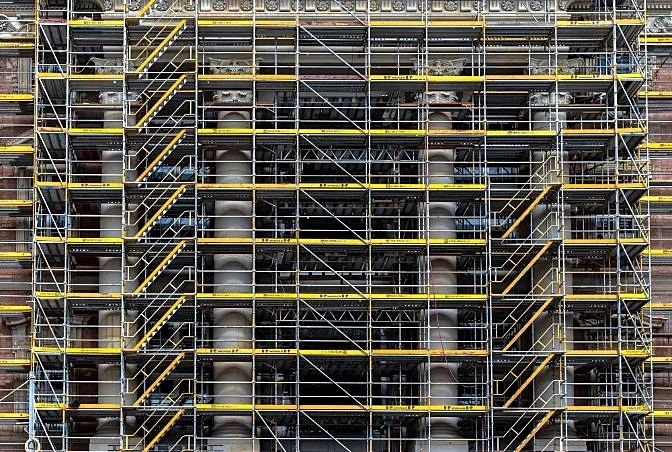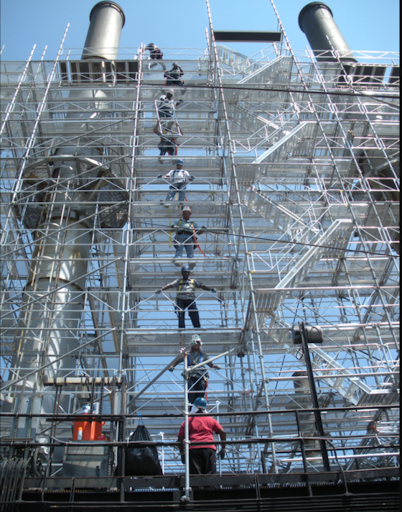Checking Out the Different Sorts Of Scaffolding Used in Construction Tasks
The construction industry relies greatly on different kinds of scaffolding to satisfy particular project demands, each offering unique benefits and applications. Standard frame scaffolding offers a tough foundation for general tasks, while put on hold scaffolding is crucial for deal with skyscraper frameworks. Other alternatives, such as system and rolling scaffolding, cater to performance and wheelchair, respectively. In addition, the cantilever variant verifies indispensable in urban atmospheres where room is constrained. Recognizing the subtleties of these scaffolding kinds is vital for enhancing safety and security and performance on building websites, prompting a closer assessment of their unique attributes and applications.

Typical Structure Scaffolding
Typical framework scaffolding is one of the most widely utilized methods in the building industry because of its toughness and flexibility. This system contains upright and horizontal frames that are assembled to produce a stable platform for products and workers. The primary elements consist of vertical blog posts, horizontal journals, and diagonal dental braces, which with each other offer a solid framework that can support significant lots.
Among the key advantages of standard structure scaffolding is its adaptability to numerous construction jobs, varying from household buildings to big industrial frameworks. The modular design enables for simple setting up and disassembly, making it reliable for both long-term and temporary tasks. In addition, the system can be customized in height and width, accommodating different building styles and site problems.
Safety is extremely important in scaffolding applications, and typical structure systems are furnished with guardrails and toe boards to prevent falls and ensure worker security. Normal inspections and adherence to security policies are important in preserving the honesty of the scaffold (Scaffolding). Overall, typical structure scaffolding stays a fundamental selection in the construction industry, giving a trustworthy system for labor and boosting general project efficiency

Suspended Scaffolding
Suspended scaffolding uses an unique option for building and construction jobs that call for access to elevated surface areas, especially in scenarios where traditional framework scaffolding may be unwise. This kind of scaffolding is usually suspended from the roofing or top degrees of a structure, making use of a system of pulleys, ropes, and platforms to produce a functioning area that can be gotten used to various elevations.
One of the main benefits of put on hold scaffolding is its versatility. It can be conveniently repositioned or lowered to fit adjustments in building demands, making it perfect for tasks such as window installation, façade job, and upkeep on skyscrapers. Furthermore, the marginal impact of suspended scaffolding enables for much better usage of ground area in metropolitan environments, where space is typically restricted.
Security is a critical consideration in making use of suspended scaffolding. Proper rigging and anchoring systems need to be utilized to make sure stability and avoid mishaps. Operators needs to likewise be learnt the risk-free use this tools. Generally, suspended scaffolding offers a effective and efficient solution for accessing hard-to-reach areas in various building and construction circumstances, boosting both performance and security on site.
System Scaffolding
System scaffolding, frequently considered a modern remedy in the scaffolding market, contains pre-engineered components that can be quickly constructed and adapted for numerous building and construction jobs. Scaffolding. This sort of scaffolding is defined by its modular design, which permits adaptability and efficiency on task websites, suiting different elevations and structural demands
Generally made from high-strength steel or aluminum, system scaffolding uses enhanced toughness and stability. The components consist of vertical articles, straight journals, and diagonal dental braces, which adjoin safely, making sure a robust structure. The layout typically includes standard fittings, simplifying setting up and disassembly procedures, therefore reducing labor time and expenses.

Rolling Scaffolding
Rolling scaffolding is a functional choice to typical set scaffolding, made for wheelchair and simplicity of use on building sites. This kind of scaffolding includes a platform sustained by frames with wheels, allowing employees to easily transfer it as required. The flexibility function considerably boosts productivity, as it minimizes downtime connected with putting together and disassembling dealt with scaffolding.
Normally constructed from light-weight products such as aluminum his response or steel, rolling scaffolding uses a durable yet mobile solution for tasks requiring regular repositioning - Scaffolding. It is specifically advantageous in jobs such as painting, drywall setup, and electric job, where accessibility to various elevations and areas is necessary
Safety is paramount in rolling scaffolding style, with attributes such as locking wheels to avoid unintended activity when being used, and guardrails to safeguard workers from drops. In review addition, numerous designs are flexible in height, suiting various project requirements.
Cantilever Scaffolding

The design of cantilever scaffolding generally involves utilizing brackets or arms anchored to a structure or structure, making it possible for the platform to expand outside safely. Safety and security is critical; hence, these scaffolds must be crafted to stand up to various tons and ecological conditions. Normal inspection and upkeep are crucial to make sure architectural integrity and employee safety.
Cantilever scaffolding is preferred for its versatility and effective use room, making it a popular option in city settings where area constraints are typical. In addition, it facilitates much easier accessibility to high altitudes, inevitably adding to the overall performance of construction jobs. As with all scaffolding types, proper training and adherence to safety criteria are crucial for workers using cantilever scaffolding.
Final Thought
To conclude, the diverse kinds of scaffolding made use of in building and construction tasks each offer distinct purposes tailored to specific site needs. Standard framework scaffolding supplies security, while suspended scaffolding provides flexibility for elevated tasks. System scaffolding promotes quick setting up, and rolling scaffolding boosts flexibility for differing workplace. Cantilever scaffolding successfully resolves barriers in city settings. Recognizing these scaffolding kinds is crucial for maximizing safety and security and productivity in construction, inevitably adding to the effective conclusion of jobs.
Traditional structure scaffolding supplies a sturdy foundation for general jobs, while suspended scaffolding is essential for work on high-rise frameworks.Rolling scaffolding is a functional alternative to traditional fixed scaffolding, created for movement and convenience of use on construction websites. As with all scaffolding types, correct training and adherence to security standards are critical for employees utilizing cantilever scaffolding.
Standard frame scaffolding offers stability, while put on hold scaffolding offers adaptability for raised tasks. System scaffolding helps with fast assembly, and rolling scaffolding improves flexibility for differing job environments.
Comments on “Discover Leading Scaffolding Near Me for Your Home or Business Needs”